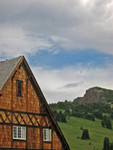
ASSET (Action to Strengthen Small European Towns)
Afternoon session
11. Ms. Kathleen Bierbaß, from the Working Group “Towns with historic centres” of the State of Brandenburg, spoke about the quality of development in small towns in Brandenburg. Kathleen explained the Federal funding programme "Städtebaulicher Denkmalschutz" (Urban Monument Protection). This had involved inter-municipal co-operation in Brandenburg, covering the smallest town (Lenzen 2,381 population) to Potsdam (1.5 million population). Her presentation generated discussion on the quality of new building in historic areas.
Hubs and service centres – Discussion: Moderated by Valerie Carter / UK
12. Valerie opened the discussion with the notion that hubs must have a hinterland. Angus Fowler drew attention to the distinction between a hub and a core. Gerhard L. Fasching, as a geographer, perceived the town and surroundings, the town having a radial impact. Ribbon development was to be avoided, as had been successful in France and Switzerland. Dirk Michaelis considered that small towns had been ignored, but there had been a focus on villages.
Irmelin Küttner described her recent visit to a Baltic coast town, where there had been successful investment in the seaside promenade and street furniture. A woodland fringe had a cycle path. Large villas had been maintained without changes to their facades. Parking spaces for visitors had been inserted discretely. New hotels and a new colonnade for small retail premises had been created. There was a range of goods and services for people with different financial capacity.
Angus Fowler stressed the importance of a market in towns, and Valerie gave the example of Andover, Hampshire UK, where the priority to attract shoppers had been to make car parks easily accessible, without litter and with clean public lavatories.
There was discussion on the importance of job creation and the support of businesses. Valerie pointed to experience in South East England, where one third of all businesses were based in small towns and rural areas. It had been difficult for business people to find time to engage with other local people in forming a vision for an area.
Frau Menz considered that young companies sometimes found that older buildings in urban areas were limited in space, and a rural environment was favoured. For architects the dream was the right client in the right building in the right area. Clusters of enterprises, such as artists and other creative industries had potential for sharing of support services and joint marketing. Gerhard urged mutual help amongst neighbours. He saw church buildings as purveyors of culture, and castles and palaces as sub-regional centres – a magnet for identity. In the past the wealthy families had great influence. Who were to be the champions of today? Former Managing Directors? One from an agricultural company in Austria has a grasp of a whole region.
| previous |